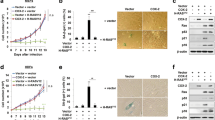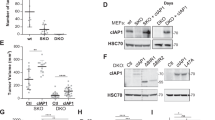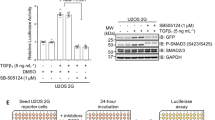Abstract
Transforming growth factor-β (TGF-β) plays complex roles in carcinogenesis, as it may exert both tumor suppressor and pro-oncogenic activities depending on the stage of the tumor. SMAD proteins transduce signals from the TGF-β receptors to regulate the transcription of specific _target genes. Crosstalks with other signaling pathways may contribute to the specificity of TGF-β effects. In this report, we have investigated the effects of cyclic adenosine 3′,5′-monophosphate (cAMP), a key second messenger in the cellular response to various hormones, on SMAD-dependent signaling in human HaCaT keratinocytes. Using either an artificial SMAD3/4-dependent reporter construct or the natural TGF-β _target, plasminogen activator inhibitor-1, we show that membrane-permeable dibutyryl cAMP, and other intracellular cAMP-elevating agents such as the phosphodiesterase inhibitor isobutyl-methylxanthine, the adenylate cyclase activator forskolin, or exogenous prostaglandin E2 (PGE2), interfere with TGF-β-induced SMAD-specific gene transactivation. Inhibition of protein kinase A (PKA), the main downstream effector of cAMP, with H-89, suppressed cAMP-dependent repression of SMAD-driven gene expression. Inversely, coexpression of either an active PKA catalytic subunit or that of the cAMP response element (CRE)-binding protein (CREB) blocked SMAD-driven gene transactivation. cAMP-elevating agents did not inhibit nuclear translocation and DNA binding of SMAD3/4 complexes, but abolished the interactions of SMAD3 with the transcription coactivators CREB-binding protein (CBP) and p300 in a PKA-dependent manner. These results suggest that suppression of TGF-β/SMAD signaling and resulting gene transactivation by cAMP-inducing agents occurs via PKA-dependent, CREB-mediated, disruption of SMAD–CBP/p300 complexes.
This is a preview of subscription content, access via your institution
Access options
Subscribe to this journal
Receive 50 print issues and online access
We are sorry, but there is no personal subscription option available for your country.
Buy this article
- Purchase on SpringerLink
- Instant access to full article PDF
Prices may be subject to local taxes which are calculated during checkout






Similar content being viewed by others
Abbreviations
- AC:
-
adenylate cyclase
- CBP:
-
CREB-binding protein
- CRE:
-
cAMP Response element
- CREB:
-
CRE-binding protein
- db-cAMP:
-
dibutyryl-cyclic AMP
- EMSA:
-
electrophoretic mobility shift assay
- FCS:
-
fetal calf serum
- IBMX:
-
isobutyl-methylxanthine
- PAI-1:
-
plasminogen activator inhibitor-1
- PGE2:
-
prostaglandin E2
- PKA:
-
protein kinase A
- TGF-β:
-
transforming growth factor-β
- TNF-α:
-
tumor necrosis factor-α
References
Andrews NC and Faller DV . (1991). Nucleic Acids Res., 19, 2499.
Atfi A, Buisine M, Mazars A and Gespach C . (1997). J. Biol. Chem., 272, 24731–24734.
Attisano L and Wrana JL . (2000). Curr. Opin. Cell Biol., 12, 235–243.
Bianco C, Bianco R, Tortora G, Damiano V, Guerrieri P, Montemaggi P, Mendelsohn J, De Placido S, Bianco AR and Ciardiello F . (2000). Clin. Cancer Res., 6, 4343–4350.
Boukamp P, Petrussevska RT, Breitkreutz D, Hornung J, Markham A and Fusenig NE . (1988). J. Cell Biol., 106, 761–771.
Chrivia JC, Kwok RP, Lamb N, Hagiwara M, Montminy MR and Goodman RH . (1993). Nature, 365, 855–859.
Corley DA, Kerlikowske K, Verma R and Buffler P . (2003). Gastroenterology, 124, 47–56.
de Caestecker MP, Piek E and Roberts AB . (2000). J. Natl. Cancer Inst., 92, 1388–1402.
Dennler S, Itoh S, Vivien D, ten Dijke P, Huet S and Gauthier JM . (1998). EMBO J., 17, 3091–3100.
Duncan MR, Frazier KS, Abramson S, Williams S, Klapper H, Huang X and Grotendorst GR . (1999). FASEB J., 13, 1774–1786.
Feng XH, Zhang Y, Wu RY and Derynck R . (1998). Genes Dev., 12, 2153–2163.
Ghosh AK, Yuan W, Mori Y, Chen S and Varga J . (2001). J. Biol. Chem., 276, 11041–11048.
Gold LI . (1999). Crit. Rev. Oncogene, 10, 303–360.
Gonzalez GA and Montminy MR . (1989). Cell, 59, 675–680.
Hottiger MO, Felzien LK and Nabel GJ . (1998). EMBO J., 17, 3124–3134.
Janknecht R, Wells NJ and Hunter T . (1998). Genes Dev., 12, 2114–2119.
Johnson TW, Anderson KE, Lazovich D and Folsom AR . (2002). Cancer Epidemiol. Biomarkers Prev., 11, 1586–1591.
Keeton MR, Curriden SA, van Zonneveld AJ and Loskutoff DJ . (1991). J. Biol. Chem., 266, 23048–23052.
Kwok RP, Lundblad JR, Chrivia JC, Richards JP, Bachinger HP, Brennan RG, Roberts SG, Green MR and Goodman RH . (1994). Nature, 370, 223–226.
Leask A, Sa S, Holmes A, Shiwen X, Black CM and Abraham DJ . (2001). Mol. Pathol., 54, 180–183.
Levy GN . (1997). FASEB J., 11, 234–247.
Massagué J and Wotton D . (2000). EMBO J., 19, 1745–1754.
Mayr B and Montminy M . (2001). Nat. Rev. Mol. Cell Biol., 2, 599–609.
Molina CA, Foulkes NS, Lalli E and Sassone-Corsi P . (1993). Cell, 75, 875–886.
Montminy M . (1997). Annu. Rev. Biochem., 66, 807–822.
Negishi M, Sugimoto Y and Ichikawa A . (1993). Prog. Lipid Res., 32, 417–434.
Pouponnot C, Jayaraman L and Massagué J . (1998). J. Biol. Chem., 273, 22865–22868.
Reiss M . (1999). Microbes Infect., 1, 1327–1347.
Rodeck U, Nishiyama T and Mauviel A . (1999). Cancer Res., 59, 547–550.
Sassone-Corsi P . (1998). Int. J. Biochem. Cell Biol., 30, 27–38.
Shen X, Hu PP, Liberati NT, Datto MB, Frederick JP and Wang XF . (1998). Mol. Biol. Cell., 9, 3309–3319.
Sheng H, Shao J, Morrow JD, Beauchamp RD and DuBois RN . (1998). Cancer Res., 58, 362–366.
Sheng H, Shao J, Washington MK and DuBois RN . (2001). J. Biol. Chem., 276, 18075–18081.
Smalley W, Ray WA, Daugherty J and Griffin MR . (1999). Arch. Intern. Med., 159, 161–166.
Topper JN, DiChiara MR, Brown JD, Williams AJ, Falb D, Collins T and Gimbrone Jr MA . (1998). Proc. Natl. Acad. Sci. USA, 95, 9506–9511.
Tortora G, Caputo R, Damiano V, Bianco R, Pepe S, Bianco AR, Jiang Z, Agrawal S and Ciardiello F . (1997). Proc. Natl. Acad. Sci. USA, 94, 12586–12591.
Tortora G and Ciardiello F . (2002). Ann. NY Acad. Sci., 968, 139–147.
Tsujii M, Kawano S, Tsuji S, Sawaoka H, Hori M and DuBois RN . (1998). Cell, 93, 705–716.
Verrecchia F, Chu ML and Mauviel A . (2001a). J. Biol. Chem., 276, 17058–17062.
Verrecchia F, Pessah M, Atfi A and Mauviel A . (2000). J. Biol. Chem., 275, 30226–30231.
Verrecchia F, Tacheau C, Schorpp-Kistner M, Angel P and Mauviel A . (2001b). Oncogene, 20, 2205–2211.
Verrecchia F, Tacheau C, Wagner EF and Mauviel A . (2003). J. Biol. Chem., 278, 1585–1593.
Vindevoghel L, Lechleider RJ, Kon A, de Caestecker MP, Uitto J, Roberts AB and Mauviel A . (1998). Proc. Natl. Acad. Sci. USA, 95, 14769–14774.
Yuan W, Condorelli G, Caruso M, Felsani A and Giordano A . (1996). J. Biol. Chem., 271, 9009–9013.
Acknowledgements
We express our gratitude to Drs Jérôme Bertherat (INSERM U567, CNRS UMR 8104, Institut Cochin, Paris, France), Corine Bertolotto (INSERM U385, Nice, France), Sylviane Dennler and Jean-Michel Gauthier (Glaxo-Wellcome, Les Ulis, France), David D. Ginty (Johns Hopkins University Medical Center, Bethesda, MD, USA), Antonio Giordano (Thomas Jefferson University, Philadelphia, PA, USA), David J. Loskutoff (Research Institute of Scripps Clinic, La Jolla, CA, USA), who kindly provided reagents. This study was supported by INSERM, Association pour la Recherche contre le Cancer (ARC), and Ligue Nationale contre le Cancer (LNCC, section de Paris), France. MS has benefited from a short-term research fellowship awarded by the René Touraine Foundation and is the recipient of a Deutsche Forschungsgemeinschaft (DFG) postdoctoral fellowship.
Author information
Authors and Affiliations
Corresponding author
Rights and permissions
About this article
Cite this article
Schiller, M., Verrecchia, F. & Mauviel, A. Cyclic adenosine 3′,5′-monophosphate-elevating agents inhibit transforming growth factor-β-induced SMAD3/4-dependent transcription via a protein kinase A-dependent mechanism. Oncogene 22, 8881–8890 (2003). https://doi.org/10.1038/sj.onc.1206871
Received:
Revised:
Accepted:
Published:
Issue Date:
DOI: https://doi.org/10.1038/sj.onc.1206871
Keywords
This article is cited by
-
Rolipram plays an anti-fibrotic effect in ligamentum flavum fibroblasts by inhibiting the activation of ERK1/2
BMC Musculoskeletal Disorders (2021)
-
Chronic inhibition of cyclic guanosine monophosphate-specific phosphodiesterase 5 prevented cardiac fibrosis through inhibition of transforming growth factor β-induced Smad signaling
Frontiers of Medicine (2014)
-
Therapeutic management of intestinal fibrosis induced by radiation therapy: from molecular profiling to new intervention strategies et vice et versa
Fibrogenesis & Tissue Repair (2012)
-
Combination of roflumilast with a beta-2 adrenergic receptor agonist inhibits proinflammatory and profibrotic mediator release from human lung fibroblasts
Respiratory Research (2012)
-
PRKAR1A overexpression is associated with increased ECPKA autoantibody in liver fluke-associated cholangiocarcinoma: application for assessment of the risk group
Tumor Biology (2012)



